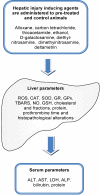Hepatoprotective effects of mushrooms
- PMID: 23884116
- PMCID: PMC6270077
- DOI: 10.3390/molecules18077609
Hepatoprotective effects of mushrooms
Abstract
The particular characteristics of growth and development of mushrooms in nature result in the accumulation of a variety of secondary metabolites such as phenolic compounds, terpenes and steroids and essential cell wall components such as polysaccharides, b-glucans and proteins, several of them with biological activities. The present article outlines and discusses the available information about the protective effects of mushroom extracts against liver damage induced by exogenous compounds. Among mushrooms, Ganoderma lucidum is indubitably the most widely studied species. In this review, however, emphasis was given to studies using other mushrooms, especially those presenting efforts of attributing hepatoprotective activities to specific chemical components usually present in the mushroom extracts.
Figures



Similar articles
-
Cellular and physiological effects of Ganoderma lucidum (Reishi).Mini Rev Med Chem. 2004 Oct;4(8):873-9. doi: 10.2174/1389557043403323. Mini Rev Med Chem. 2004. PMID: 15544548 Review.
-
Mycotherapy of cancer: an update on cytotoxic and antitumor activities of mushrooms, bioactive principles and molecular mechanisms of their action.Curr Top Med Chem. 2013;13(21):2791-806. doi: 10.2174/15680266113136660198. Curr Top Med Chem. 2013. PMID: 24083788 Review.
-
Antioxidant and Hepatoprotective Activities of Crude Polysaccharide Extracts from Lingzhi or Reishi Medicinal Mushroom, Ganoderma lucidum (Agaricomycetes), by Ultrasonic-Circulating Extraction.Int J Med Mushrooms. 2018;20(6):581-593. doi: 10.1615/IntJMedMushrooms.2018026536. Int J Med Mushrooms. 2018. PMID: 29953354
-
Comparative characterization of physicochemical properties and bioactivities of polysaccharides from selected medicinal mushrooms.Appl Microbiol Biotechnol. 2016 May;100(10):4385-93. doi: 10.1007/s00253-015-7260-3. Epub 2016 Jan 8. Appl Microbiol Biotechnol. 2016. PMID: 26743656
-
Effect of Cultured Substrates on the Chemical Composition and Biological Activities of Lingzhi or Reishi Medicinal Mushroom, Ganoderma lucidum (Agaricomycetes).Int J Med Mushrooms. 2020;22(12):1183-1190. doi: 10.1615/IntJMedMushrooms.2020037133. Int J Med Mushrooms. 2020. PMID: 33463935
Cited by
-
Characterization of Polysaccharides with Antioxidant and Hepatoprotective Activities from the Edible Mushroom Oudemansiella radicata.Molecules. 2017 Feb 4;22(2):234. doi: 10.3390/molecules22020234. Molecules. 2017. PMID: 28165422 Free PMC article.
-
Protection of Inonotus hispidus (Bull.) P. Karst. against Chronic Alcohol-Induced Liver Injury in Mice via Its Relieving Inflammation Response.Nutrients. 2023 Aug 10;15(16):3530. doi: 10.3390/nu15163530. Nutrients. 2023. PMID: 37630721 Free PMC article.
-
Wild mushrooms showed analgesic and cytotoxic properties along with phytoconstituent's binding affinity to COX-1, COX-2 and cytochrome P450 2C9.Heliyon. 2021 Sep 14;7(9):e07997. doi: 10.1016/j.heliyon.2021.e07997. eCollection 2021 Sep. Heliyon. 2021. PMID: 34585013 Free PMC article.
-
Ganoderma lucidum: Current advancements of characteristic components and experimental progress in anti-liver fibrosis.Front Pharmacol. 2023 Jan 9;13:1094405. doi: 10.3389/fphar.2022.1094405. eCollection 2022. Front Pharmacol. 2023. PMID: 36703748 Free PMC article. Review.
-
Antioxidant Activity and Protective Effects of Enzyme-Extracted Oudemansiella radiata Polysaccharides on Alcohol-Induced Liver Injury.Molecules. 2018 Feb 23;23(2):481. doi: 10.3390/molecules23020481. Molecules. 2018. PMID: 29473842 Free PMC article.
References
-
- Manzi P., Gambelli L., Marconi S., Vivanti V., Pizzoferrato L. Nutrients in edible mushrooms: An inter-species comparative study. Food Chem. 1999;65:477–482. doi: 10.1016/S0308-8146(98)00212-X. - DOI
-
- Mishra S., Singh R.B. Effect of mushroom on the lipid profile, lipid peroxidation and liver functions of aging Swiss albino rats. Open Nutrac. J. 2010;3:248–253.
Publication types
MeSH terms
Substances
LinkOut - more resources
Full Text Sources
Other Literature Sources
Medical

